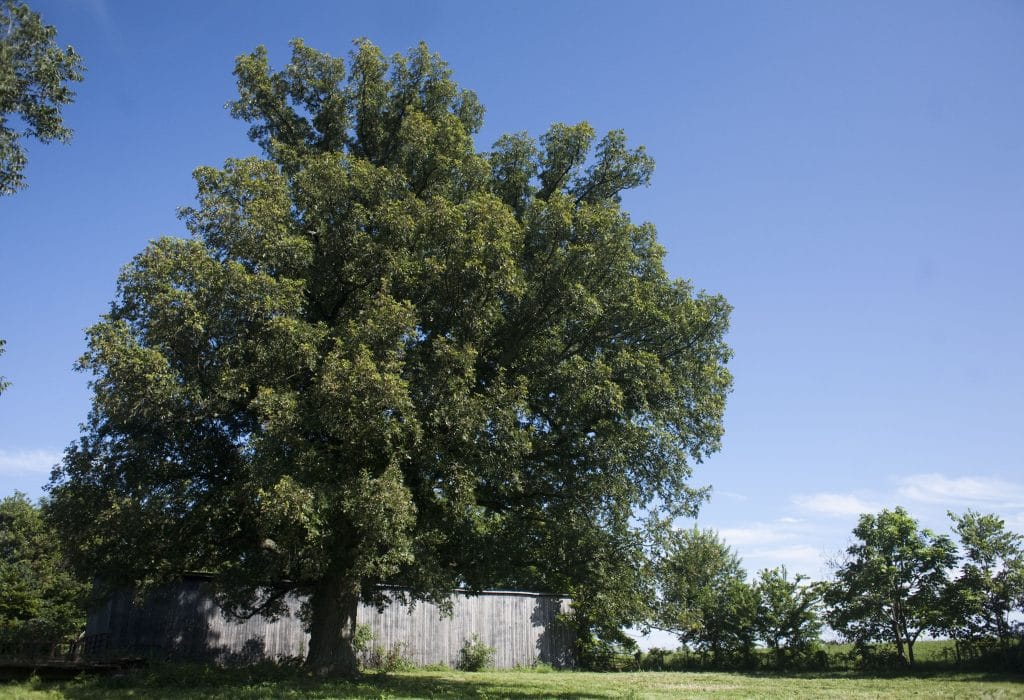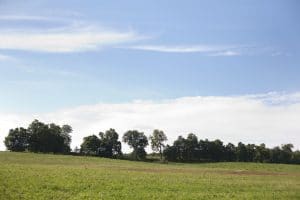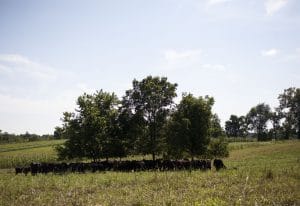
Trees of the Bluegrass have played a tremendous role in defining the culture and fabric of this region. From the venerable beauties that dot the landscape to the stout trees in the active fencerows and the younger trees throughout small wood lots, managing the trees is foundational to our land-stewardship principles. It is also integral to our organic way of living within an ecosystem, not forcing our will upon the land we have been entrusted with.
Looking around Elmwood Stock Farm, one thing that may catch your eye is the huge trees, randomly scattered in a pasture or near dwellings. These are the venerable, or pre-settlement trees, unique to the region we farm. As the land was settled, writings tell of finding native grasslands with these big beauties interspersed, probably evolving with bison herds and wildfires. Settlers built their farms among them, with reverence. There was a collective knowledge among settlers about what the trees were telling them about the fertility and seasonal weather patterns that would foster healthy farming systems. Some trees were used to build homes and structures; others reserved for furniture or sale for cash money. Clearing land to grow tobacco and food crops was difficult with the tools at their disposal, and the stumps were quite daunting.
It is mind-boggling to think what the trees that were left may have witnessed, back when Native Americans chose to encourage their growth. We find quite a few arrowheads, or pieces of arrowheads, on the farm each year. Those hunters may have counted on these same trees for food and shelter. Elmwood has a rather large cave opening at the base of one of the many sinkholes, undoubtedly providing shelter to early human beings living off the land. The North Fork of Elkhorn Creek is our southern boundary, which not only provided a source of water but a method of transporting people and products. The riparian area adjacent to the creek is host to some truly spectacular Sycamore and Walnut trees, which with others, have vital stream-bank protection properties.

Really big trees often act as anchors of fencerows, even being named in deeds of properties. Fencerows are an active part of the farm’s management schemes and provide a host of resources. Not only do they provide shade or a wind break for livestock and crops, the microclimate they form has a tremendous impact on the wildlife they foster. Obviously, the birds seek refuge there to rear their young, but those same birds forage on insects, which helps keep the populations in check. Birds also eat weed seeds, of which we have our share. Trees that get damaged by wind or struck by lightning are often left to naturally decompose, and they in turn become a host for more insects or nesting sites. We hear various species of woodpeckers working for food, which aids in the decomposing process. Raptors and buzzards like the exposed, larger branches, high above the ground, to scout their prey or to rest.
Additionally, fencerows with a good diversity of plant species are the over-wintering habitat for the many beneficial insects we cohabitate with. We actually purchase and release various types of parasitoids or predatory beneficial insects to help keep the bad bugs at bay.
Underneath all of this, fencerows are like highways for wildlife, such as raccoons, fox, coyotes, skunks and the like, to access water from Elkhorn Creek. Some individuals of these species have discovered our irrigation systems can be a source of water. If they find a small leak, they can get enough water during the night. In extremely dry weather, they will actually just pick a place and chew the lines to create a water source. There are countless dens or homes for many of these mammals tucked under tree-root systems, in hollowed-out cavities in logs—either standing or fallen— and in any barn or shelter that sees minimal farming activity.
Invasive plant species, such as bush honeysuckle and spotted hemlock, are threatening the diversity of many fencerows in the region. We fight them back a little every year.

Our interaction with the trees is considerable within our farming business. Each spring, or often after big summer storms, we have to cut up fallen limbs, if not whole trees. After the big March ice storm several years back, a guy named Edgar showed up looking for work, cleaning up the hundreds, if not thousands, of fallen limbs and trees damaged by the storm. The damage was made worse by the storm’s timing, as many species had already broken dormancy and had their buds swelling for flowering, which gave more surface area to catch the inch of ice that coated everything. Edgar ended up working here that whole year, clearing the fields and rebuilding fences. Some of the wood piles from that event are still evident today and provide more housing for wildlife and insects. The damaged trees do provide firewood for one greenhouse and for our homes, but the clean-up—essential though it may be—takes a lot of time that could be used for other projects or jobs on the farm. Running up on a hidden limb can damage hay-making equipment, while limbs left in fields can allow weeds to grow up around them.
We have lots of Wild Cherry trees on Elmwood, which when damaged in a storm, the wilted leaves are very toxic to livestock (but not when fresh or dry). Wild Cherry are also home to the dreaded tent caterpillars of such concern to horse farmers in the region. Cattle do keep the lower branches pruned back while they browse as part of their eating habits, making it easier to actually access the fence for which this row of trees is so named. There is some debate in cattle farming circles about why cattle eat the lower leaves and even small branches when they have access to lush bluegrass and clover pasture. We believe there may be micronutrients or even natural compounds that inhibit the growth of ruminant animals’ internal parasites. We witness them eating leaves or whole plants that are said to be toxic with no ill effects. It is our belief that they inherently benefit from small doses of these plant materials but are not forced to eat too much at any one time as they rotate through the farm.
Since cattle seek the shelter and security of trees in herds, they can compact the soil under these trees, if allowed to congregate over long periods of time. The roots are starved of oxygen in these conditions. The quick rotational-grazing management plan we employ allows smaller plants to regrow under the trees between grazings, which loosens up the soil again. We are seeing the benefit to the trees already.
Adequate shade for livestock is an important aspect of good animal husbandry. We are very conscious of the shade potential for each field as we move the herds around the farm. Providing protection from the strong afternoon sun has been shown in research studies to keep body temperatures in check, which in turn stimulates a greater grazing habit, which leads to more meat or milk production in hot weather.
Grazing habits for ruminants is much the same as their wild counterparts throughout the world. The entire herd leaves the security of the trees, wanders through the grasslands—or pastures, in our case—selecting the most nutritious forage available to them. They fill up the first and largest of their four stomaches, called the rumen, then return to the safety and shelter of the trees, for rumination, or chewing the cuds to extract the nutrients from the forage. If shade is limited, the herd can hurt the trees by spending so much time in such a small area.
We feel a strong sense of responsibility for these trees, as they have watched over many changes since this land was settled. We want the growth rings to reflect how respectful we are of them. It is obvious to us where the word tremendous came from. —Mac Stone
(An abbreviated version of this article appears in a previous Elmwood CSA newsletter.)



Made with 
